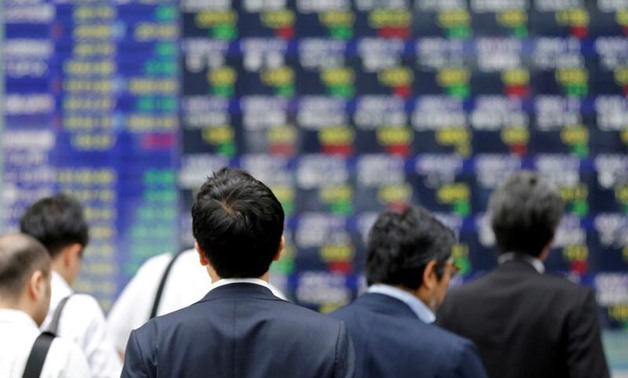
FILE PHOTO: People walk past an electronic stock quotation board outside a brokerage in Tokyo, Japan, September 22, 2017. REUTERS/Toru Hana
LONDON - 16 May 2019: European stocks fell, government bond yields slipped and the Japanese yen firmed on Thursday after the U.S. government hit Chinese telecoms giant Huawei with severe sanctions, further straining Sino-U.S. trade ties.
An index of European shares fell as much as 0.5 percent in early European trading with the German stock index down 0.4 percent. U.S. stock futures were down 0.4 percent, pointing to a weak start on Wall Street.
The broad weakness in European markets was somewhat offset by small gains in Chinese and Hong Kong stock indexes leading to only marginal losses on a global stock index as investors expected state authorities to step in to support the market and stabilize sentiment.
“Chinese stocks are up as markets expect authorities to intervene to support sentiment but this kind of activity is not sustainable and unless we see a clear resolution in the China-U.S. trade conflict, overall sentiment will remain weak,” said Neil Mellor, a senior FX strategist at BNY Mellon in London.
While benchmark indexes in China and Hong Kong were up between 0.3-0.8 percent at the close of trading, bond markets were signalling more pain for risk appetite.
Core German government bond yields were flirting with their lowest level in nearly three years while Dutch bond yields were about to dip into negative territory, a phenomenon not seen since October 2016.
Late on Wednesday, the U.S. Commerce Department said it was adding Huawei Technologies Co Ltd and 70 affiliates to its “Entity List” - a move that bans the company from acquiring components and technology from U.S. firms without government approval.
The move took global markets by surprise as sentiment had steadied somewhat in the previous session on news that U.S. President Donald Trump was planning to delay tariffs on auto imports after a swathe of weak U.S. and Chinese economic data.
RATE CUT BETS GROW
As trade tensions have made a reappearance on investors’ radars, weak U.S. data has also ratcheted up market expectations of a U.S. interest rate cut in the coming months.
In the United States, retail sales unexpectedly fell in April as households cut back on purchases of motor vehicles and a range of other goods, while industrial production fell 0.5 percent in April, the third drop this year.
Yields on 10-year U.S. Treasury bonds eased to 2.366 percent, near a 15-month low of 2.340 percent touched on March 28.
Fed funds rate futures are fully pricing in a rate cut by the end of this year and more than a 50 percent chance of a move by September.
“The markets are inching step by step in pricing in a rate cut. That is a sea change from a year ago when the consensus was three to four rate hikes a year,” said Akira Takei, bond fund manager at Asset Management One.
Falling U.S. yields have eroded support for the greenback with the dollar down 0.1 percent against a basket of its rivals.
Oil prices gained on the prospect of mounting tensions in the Middle East hitting global supplies despite an unexpected build in U.S. crude inventories.
Brent crude rose 0.3 percent to $71.99 a barrel, while U.S. West Texas Intermediate (WTI) crude fetched $62.26, also half a percent higher.
Gold edged up to $1,296.9 per ounce.

Comments
Leave a Comment